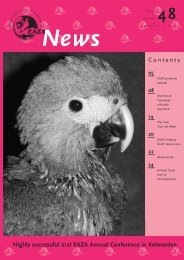OXYURIASIS
OXYURIASIS
OXYURIASIS
You also want an ePaper? Increase the reach of your titles
YUMPU automatically turns print PDFs into web optimized ePapers that Google loves.
ANIMAL<br />
GROUP<br />
AFFECTED<br />
All primate<br />
genera<br />
EAZWV Transmissible Disease Fact Sheet Sheet No. 117<br />
TRANS-<br />
MISSION<br />
CLINICAL<br />
SIGNS<br />
Perorally Perianal itching,<br />
anorexia, weight<br />
loss<br />
<strong>OXYURIASIS</strong><br />
FATAL<br />
DISEASE ?<br />
Fact sheet compiled by Last update<br />
Manfred Brack, formerly German Primate Center, November 2003<br />
Göttingen / Germany.<br />
Fact sheet reviewed by<br />
W. Rietschel, Wilhelma Zoologischer-Botanischer Garten, Stuttgart, Germany<br />
C. Furley, Howletts Zoo, Bekesbourne, United Kingdom<br />
Susceptible animal groups<br />
Depending on the oxyurid-species.<br />
Causative organism<br />
Enterobius spp. – Cercopithecoidea, Pongidae, Hylobatidae, man,<br />
Colobenterobius spp. – Colobinae,<br />
Probstmayria spp. – Pongidae, Macaques,<br />
Lemuricola spp. -Prosimiae,<br />
Trypanoxyuris spp. - New World monkeys.<br />
Zoonotic potential<br />
Only with Enterobius vermicularis.<br />
Distribution<br />
Enterobius spp.- World- wide , more common in temperate climates.<br />
Colobenterobius spp. - Asia, Africa,<br />
Probstmayria spp. – Africa, India,<br />
Lemuricola sp. – Madagascar,<br />
Trypanoxyuris spp. – South- and Central America.<br />
Transmission<br />
Perorally.<br />
Incubation period<br />
Yes<br />
TREATMENT PREVENTION<br />
& CONTROL<br />
Fenbendazole<br />
In houses<br />
in zoos<br />
Clinical symptoms<br />
Perianal itching, anorexia, restlessness, weight loss, death.<br />
Post mortem findings<br />
Caecal/ colonic/ rectal mucosal hyperaemia, oedematous thickening or fibrosis of the large intestinal wall,<br />
nodular lesions and focal necroses in the intestinal wall, enterocolitis.<br />
Diagnosis<br />
Ovodiagnosis (Anal impression!).<br />
Material required for laboratory analysis<br />
Anal swabs, faeces, spontaneously eliminated worms (Preservation in Raillet & Henry solution: 920 ml 0.8%<br />
NaCl, 30 ml 40% formalin, 50 ml glacial acetic acid)<br />
Relevant diagnostic laboratories<br />
Treatment<br />
1. Fenbendazole (10 mg / kg). In man 85% cure rate with 50 – 150 mg Ivermectin.<br />
Prevention and control in zoos<br />
Suggested disinfectant for housing facilities<br />
Notification<br />
1
Guarantees required under EU Legislation<br />
Guarantees required by EAZA Zoos<br />
EAZWV Transmissible Disease Fact Sheet Sheet No. 117<br />
Measures required under the Animal Disease Surveillance Plan<br />
Measures required for introducing animals from non-approved sources<br />
Measures to be taken in case of disease outbreak or positive laboratory findings<br />
Conditions for restoring disease-free status after an outbreak<br />
Experts who may be consulted<br />
References<br />
1. deMelo, A. L., and L. H. Pereira. 1985. Sobre o parasitismo por Primasubulura jacchi em Callithrix<br />
penicillata (Primates, Callitrichidae). Primatol. Bras 2: 483-485.<br />
2. Düwel, D., and K. Brech. 1981. Control of oxyuriasis in rabbits by fenbendazole. Lab. Anim. 15: 101-105.<br />
3. Düwel, D., R. Kirsch, und E. Weinmann. 1979. Zur anthelminthischen Behandlung von Javaneraffen<br />
(Macaca irus) mit Panacur. Verh. ber. Erkr. Zootiere 21: 305-309.<br />
4. Holmes, D. D., S. D. Kosanke, G. L. White, and W. B. White. 1980. Fatal enterobiasis in a chimpanzee. J.<br />
Am. Vet. Med. Assoc. 177: n911-913.<br />
5. Hugot, J. P. 1999. Primates and their pinworm parasites: The Cameron hypothesis revisited. Syst. Biol.<br />
48: 523-554.<br />
6. Hugot, J. P., S. L. Gardner, and S. Morand. 1996. The enterobiinae subfam. nov. (Nematoda, Oxyurida)<br />
pinworm parasites of primates and rodents. Int. J. Parasitol. 26: 147-159.<br />
7. Keeling, M. E., and H. M. McClure. 1974. Pneumococcal meningitis and fatal enterobiasis in a<br />
chimpanzee. Lab. Anim. Sci. 24: 92-95.<br />
8. Murata, K., H. Hasegawa, T. Nakano, A. Noda, and T. Yanai. 2002. Fatal infection with human pinworm,<br />
Enterobius vermicularis, in a captive chimpanzee. J. Med. Primatol. 31: 104-108.<br />
9. Naquira, C., G Jimenez, J. G. Guerra, R. Bernal, D. R. Nalin, D. Neu, and M. Aziz. 1989. Ivermectin for<br />
human strongyloidiasis and other intestinal helminths. Am. J. Trop. Med. Hyg. 40: 304 – 309.<br />
10. Prieto, O. H., A. M. Santa Cruz, N. Scheibler, J. T. Borda, and L. G. Gomez. 2002. Incidence and external<br />
morphology of the nematode Trypanoxyuris (Hapaloxyuris) callithricis , isolated from black- and gold<br />
howler monkeys (Alouatta caraya) in Corrientes, Argentina. Lab. Primate Newsl. 41 (3): 12 – 14.<br />
11. Zhang, G.-W., X.-R. Ji, and D. P. McManus. 1994. The presence of pinworm (Enterobius sp.) in the<br />
mesenteric lymph nodes, liver and lungs of a chimpanzee, Pan troglodytes. J. Helminthol. 64: 29-34.<br />
2
















